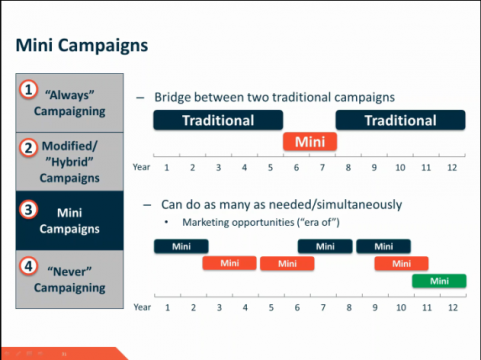Recently, I attended a webinar hosted by CCS Fundraising about campaigns and how to avoid the dreaded lull period. According to CCS, organizations typically see a 65% increase in fundraising during campaigns. However, the post-campaign period can fall into a lull, which can lead to a bit of a tough time to get through. Through this webinar, CCS identified 4 campaign models that could possibly help mitigate that lull.
With the “Always” Campaign approach, (it’s relatively self-explanatory) you are continuously campaigning. You do have specific themes of tasks you want to accomplish with fundraising. And it can be fun because your organization is in a perpetual “celebration phase.” The down side to this approach (which I am sure you have already guessed) is increasing the risk of donor fatigue.
This popular model is a blend of traditional and non-traditional campaigns. There is a timeframe as well as a financial goal that you want to achieve, which are a part of a traditional campaign model. However, you have non-specific funding priorities- your fundraising goal is flexible. You don’t necessarily ask the board members to donate first or last, which makes this approach a non-sequential fundraising method. It’s more of a donor-centric model, so you ask them for a donation when they are ready to be asked and depending on their interests. This allows you to be more strategic in fulfilling your philanthropic goals.

Example of a “Mini” Campaign timeline provided by CCS Fundraising
This particular model appears to be similar to the “Always” Campaign, however these “Mini” Campaigns have tangible deadlines. You are able to do as many “Mini” Campaigns as needed and even do them simultaneously, which helps create more marketing opportunities and keeps donor interest.
This one is literal- you are never running a specific campaign. In a sense, raising money is institutionalized; it’s part of the everyday workflow of the organization. The benefits of this approach allow you to use fewer resources and minimize the volunteer role because you are using the people who already work for your organization. This approach can also lessen the possibility of campaign fatigue mindset. An example of an organization that implements this model effectively is St. Jude’s. Every year, they have their Thanksgiving fundraiser but the donations don’t stop once the event is over- the fundraiser continues all year round.
Have you tried any of these campaign techniques? What was your experience trying something outside the traditional model?